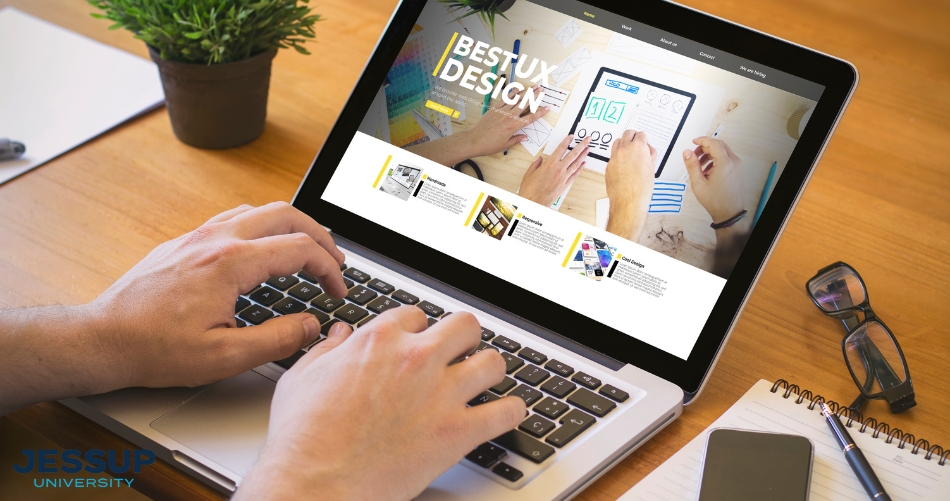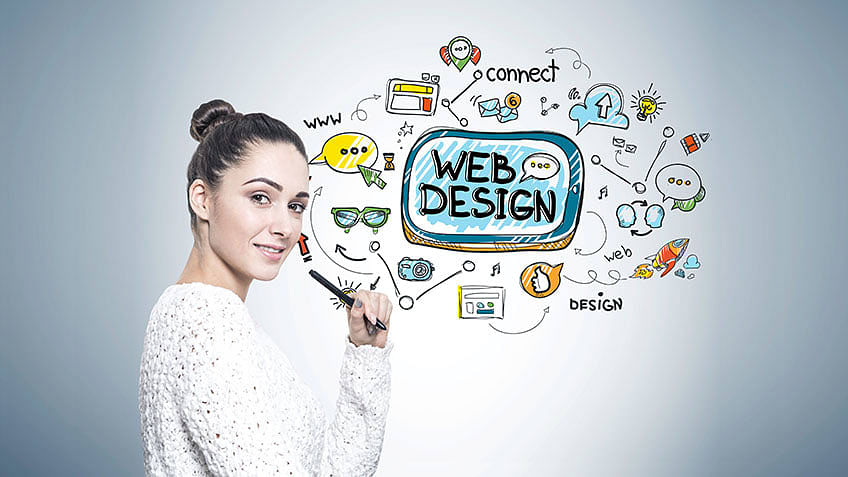How a web design company transforms user experience and boosts conversions
Wiki Article
Discovering Innovative Trends in Web Design for Modern Businesses
The landscape of web design is continuously advancing, showing the dynamic needs of contemporary services. Recent trends highlight a choice for minimalism, strong typography, and engaging interactivity. Business increasingly prioritize user experience with mobile-first principles and individualized material. Furthermore, a concentrate on sustainability is gaining traction. Understanding these trends is necessary for businesses intending to attract attention in a congested market. What implications do these shifts hold for the future of electronic interaction?Accepting Bold Typography
Bold typography has actually emerged as a specifying element in modern web design, catching interest and communicating messages with striking quality. This pattern prioritizes aesthetically impactful message that improves user interaction and brand identification. Designers typically make use of extra-large fonts and one-of-a-kind typefaces to create a pecking order, assisting viewers with content effortlessly.
The tactical usage of bold typography allows for reliable storytelling, enabling brands to communicate their values succinctly. It offers not just aesthetic purposes yet likewise practical ones, as it enhances readability throughout gadgets and display dimensions.
As internet sites contend for user attention, strong typography attracts attention in a saturated digital landscape. Its versatility enables designers to try out contrasting shades and designs, better enhancing its efficiency. Inevitably, welcoming bold typography represents a change in the direction of more expressive and communicative web design, fostering a deeper connection between brand names and their audiences.
The Rise of Minimalist Style
As digital atmospheres become significantly cluttered, the rise of minimalist design uses an invigorating choice that focuses on simpleness and capability. This layout approach remove unneeded elements, permitting content to take facility stage. By concentrating on tidy lines, sufficient white space, and a restricted shade scheme, minimalist layout boosts user experience and improves navigation.Businesses embracing this pattern purpose to communicate their brand message clearly and successfully, cultivating a sense of tranquility and quality. The absence of diversions helps individuals concentrate on crucial details, causing enhanced interaction and conversion rates. In addition, minimal style aligns well with mobile-first approaches, ensuring that internet sites continue to be easily accessible and easy to use across different tools.
Ultimately, the rise of minimal style shows a broader shift towards focusing on user needs and choices, making it a powerful tool for modern-day organizations seeking to make a long lasting influence in the digital landscape.
Immersive Animations and Interactivity
While several internet designers welcome minimalist appearances, another engaging trend getting traction is making use of immersive animations and interactivity. This method enhances user interaction by developing interesting experiences that attract visitors into the content. Designers utilize dynamic aspects such as computer animated histories, scrolling impacts, and interactive infographics to communicate complex concepts in an easily accessible manner.These animations not just offer visual passion yet likewise overview customers through the navigation procedure, making interactions more intuitive. As an example, float effects and computer animated shifts can encourage users to explore additionally, bring about enhanced time spent on the site.
This trend aligns with the more comprehensive movement in the direction of narration in internet layout, where computer animations offer as narrative devices that convey brand name messages properly. By incorporating immersive computer animations and interactivity, services can distinguish themselves in a crowded online landscape, inevitably improving user contentment and brand name commitment.
Mobile-First Style Concepts
Mobile-first design concepts highlight focusing on user experience by ensuring internet sites operate perfectly on smaller displays. This technique includes responsive layout techniques that adapt to different gadget sizes while keeping visual integrity. Furthermore, it focuses on touchscreen navigating design, boosting functionality for mobile individuals.Prioritizing User Experience
Exactly how can designers successfully prioritize user experience in a significantly mobile-centric world? Stressing mobile-first style principles is important, as individuals mainly engage with websites via smart phones. This technique urges developers to improve content, ensuring it is quickly obtainable and accessible on smaller sized displays. Secret practices include streamlining navigating, reducing tons times, and utilizing touch-friendly elements that enhance interactivity. Additionally, prioritizing clear typography and instinctive layouts can substantially improve user satisfaction. Designers ought to continually gather user comments to fine-tune their techniques, adapting to advancing user requirements and choices. By concentrating on these aspects, organizations can develop an interesting digital experience that promotes commitment and drives conversions, ultimately aligning with the expectations these days's mobile customers.Receptive Format Strategies
Developers accept responsive format methods to create adaptable and adaptive internet experiences that satisfy different display dimensions. This strategy prioritizes mobile-first layout principles, guaranteeing peak performance on smaller gadgets before scaling up for larger screens. By using fluid grids, adaptable images, and media queries, designers can preserve a cohesive visual identification across all systems. This method not just improves user involvement yet likewise boosts search engine rankings, as mobile-friendly sites are favored by search algorithms. In addition, receptive formats enable companies to reach a wider target market, suiting customers on desktops, tablet computers, and smartphones alike. On the whole, executing these strategies is crucial for modern web design, making sure that businesses continue to be affordable in an ever-evolving electronic landscape.Touchscreen Navigation Layout
With the increase of mobile devices, touchscreen navigation has become a fundamental facet of web design. Developers are progressively embracing mobile-first principles to boost user experience and engagement. agency for web design. Efficient touchscreen navigation focuses on larger buttons and intuitive motions, allowing customers to connect quickly with material. This method reduces disappointment and urges expedition, as users can navigate effortlessly with their fingers. In addition, including swipe gestures and faucet functionality deals with the natural habits of mobile individuals. Responses devices, such as visual hints and computer animations, improve usability better by validating activities. As touchscreens dominate address user communications, employing these style components not just straightens with contemporary expectations however also fosters a more accessible and pleasurable browsing experience for all individualsCustomized User Experiences
What makes a user really feel genuinely engaged on a web site? The answer often lies in customized user experiences. By tailoring material and navigation to private choices, companies can create a purposeful connection with their target market. This imp source customization can be accomplished via different approaches, such as evaluating user habits, using cookies, and using personalized recommendations based upon previous communications.Shopping platforms that suggest items based on surfing background not just enhance user experience yet additionally enhance conversion prices. Incorporating vibrant web content that adapts to the user's area or time of day can further improve engagement.
In addition, tailored greetings or messages can make customers feel valued and comprehended. As modern companies strive to stand out in an affordable digital landscape, welcoming individualized user experiences ends up being essential, promoting commitment and motivating repeat brows through. Ultimately, this approach changes a standard internet site into an interactive platform that reverberates with its target market.
Sustainability in Web Design
As the digital landscape proceeds to develop, the value of sustainability in web design has obtained significant attention. Designers are progressively conscious of the ecological effect their developments can have, triggering a change towards environmentally friendly practices (Web Design Agency). Lasting web design concentrates on maximizing sites to lower energy consumption and carbon impacts. Techniques consist of using minimalistic layout concepts, maximizing images, and employing efficient coding practices to enhance loading speedsThe choice of holding carriers plays an important function; many developers are currently opting for eco-friendly organizing services powered by sustainable power. By prioritizing ease of access and user-friendly navigating, lasting designs additionally satisfy a wider audience, boosting functionality. This conscious strategy not only interest environmentally-minded customers however also contributes to the total longevity and efficiency of web sites. Eventually, sustainability in web design mirrors an expanding fad towards accountable electronic practices that straighten with contemporary organization values.

Often Asked Inquiries
Just How Can I Choose the Right Color Pattern for My Website?
To pick the ideal color pattern for an internet site, one should consider the brand name's identification, target audience, and emotional impact. Utilizing shade theory and testing combinations can improve user experience and aesthetic allure considerably.What Are the Finest Devices for Prototyping Internet Layouts?
The very best devices for prototyping web designs include Figma, Map out, Adobe XD, and InVision. These platforms supply instinctive user interfaces, collaboration features, and substantial collections, making them optimal for designers to develop and improve their ideas properly.Just how Do I Determine the Performance of My Web Design?
To measure web design effectiveness, one should analyze user engagement metrics, conversion prices, and functionality responses (Web Design services). A/B testing and heatmaps can Discover More Here likewise give insights into user habits, directing needed adjustments for improved efficiency and user experienceWhat Prevail Web Design Errors to Prevent?
Common web design blunders consist of cluttered formats, poor navigating, sluggish loading times, lack of mobile optimization, poor contrast, and neglecting user responses. Avoiding these mistakes boosts user experience and increases general effectiveness of the web site.Just how Frequently Should I Update My Web Site Layout?
An internet site design need to be updated every 2 to 3 years, or faster if substantial adjustments in branding or technology happen. Routine updates maintain the website fresh, practical, and lined up with existing user assumptions.
Report this wiki page